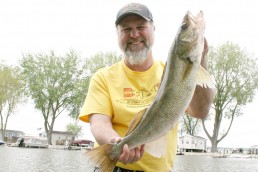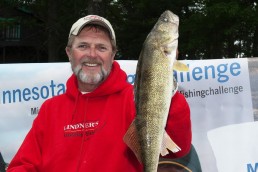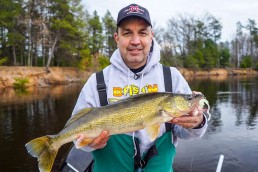The Weed Edge is Where Walleyes Roam
SHARE THIS POST
Weeds are the new rocks! The weed edge is where walleyes roam. You can cast it, jig it, rig it or run slip bobbers over it. Give the weed edge a try right now if you are in walleye country.
Here are some tips to get you fishing correctly.
When walleyes are relating to the weeds and working the edge, here is what I have found: Early morning, near dark and on cloudy days, the walleyes will roam the edge out away from the weeds. During the brightest and hottest parts of the day, walleyes will bury themselves into the edge. Here is what you can do to get them.
Jigs are great for working the edge and the interior of the edge. There are two styles of jigs that will work in the weeds— standard jigs and weedless. Cast a standard jig into the weed edge and you will snag up. This can bad or a good thing. Bumping and moving the weeds is good because this attracts fish; snagging and pulling your jig back with a pile of weeds obviously spooks them.
So, what to do? Use the lightest jig possible that you can pitch to the weed edge. Tip your jig with live bait or plastic. ‘Crawlers and leeches are good this time of year. Plastic, like the AuthentX Ribb-Finn, is great because it will stay on the jig better than live bait and still has a lifelike action.
If you haven’t tried plastic and really love live bait, then use both. Then, once you start catching fish, just fish with the plastic. Once you get your confidence up and become a believer, you will open up a whole new way to look at walleye fishing, because walleyes hit jigs and plastics wherever they are present!
I like B-Fish-N Tackle H2O jigs since they have the weight stamped right on them, which makes jig selection easy. They also have a wire clip that will hold live bait and plastic tight to the head. Finally, they are available in a myriad of colors and wide selection of weights.
One top combo for me has been a 3/32-ounce purple glitter H2O jig with a tequila sunrise Ringworm. I’ll position the boat about 20 feet from the edge and cast right into it. I want to snag up a little so that I can jiggle the rod tip to work the jig free from the weeds. This jiggling movement will attract a bite, which is usually just a little tick; that’s when you set the hook. As mentioned before, you can use live bait on this jig if you prefer.
Another option is to use a weedless jig like the B-Fish-N Tackle Draggin’ Jig. This jig has a fiber weedguard that keeps off the weeds and allows the jig to slip thru the thick stuff. Again, you can use live bait or plastic. I like the 1/16-ounce Draggin’ Jig for heavy cover. Unlike bass fishing, where bass can be all the way into the thickest, shallowest cover, I’ve found that walleyes prefer the edge— and when the edge is thick, use the Draggin’ Jig.
Are you enjoying this post?
You can be among the first to get the latest info on where to go, what to use and how to use it!
You can rig the edge when the time is right. I like a Lindy Rig set-up with a light weight of 1/8- to ¼-ounce, a two-foot leader of fluorocarbon and a jumbo leech or minnow on a number 6 hook. I’ll use the Terrova on the bow of the Lund to pull me along the edge. When starting out the day, I’ll set up the Lindy Rig in the rod holder and pitch my H2O jig into the weed edge—a deadly one-two punch!
When the wind is blowing hard into the weeds, it is a great time to fish them. Position your boat away from the edge and put the bowmount on anchor lock (aka Spot Lock). You can also anchor up. Pitch your jigs into the weeds and work them as stated before. If the wind is so strong that your line bows and you can’t see strikes, it’s time for a slip bobber. A slip bobber is also great to use when the water is clear.
I’m not a fan of bobber fishing. I like a more aggressive approach. But that being said, I’ll fish a slip bobber when the time is right. A slip bobber consists of a bobber, a slip knot and a stopper bead. It allows you to fish a variety of depths and works well with lively bait.
I’ll start by sliding the knot, bead and bobber up my mono line and then tie on a 1/16-ounce H2O jig. This is the lightest jig B-Fish-N Tackle makes, and light is best with a slip bobber. Then I’ll add a few split shots up a few feet from my jig to help keep the bobber into position and slow its drift. I figure the depth to set the bobber at by checking the depth at the weed edge. Then you tighten the knot, trim the ends and cast it out about halfway to the edge. Keep feeding line until it floats right up to the edge.
When the wind has been blowing into the weed edge for a few days, the weed edge gets red hot! Monitoring a slip float or two slip floats when walleyes are actively feeding is a lot of work and a lot of fun.
Mix things up and give it a try! Fish the weed edge this month; it is where the walleyes roam, and it will make you a believer, too!
Become a MidWest Outdoors Insider here!
MWO
SHARE THIS POST
Did you enjoy this post?
You can be among the first to get the latest info on where to go, what to use and how to use it!
Walt Matan
Walt Matan has been a writer and television host for MidWest Outdoors for 30 years. An avid ice and open-water fisherman, he currently lives in the Quad Cities on the shores of the Mississippi River. He is the product developer and brand manager for Custom Jigs & Spins, B-Fish-N Tackle, and Rippin Lips Catfish Tackle. For more information visit customjigs.com.



